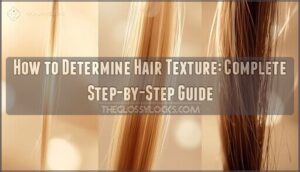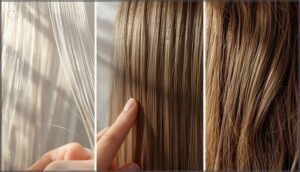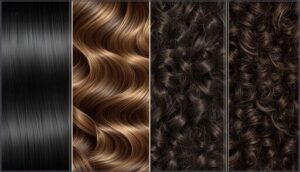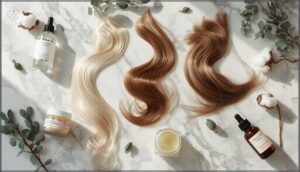This site is supported by our readers. We may earn a commission, at no cost to you, if you purchase through links.
You’ve probably grabbed the wrong products for years, wondering why your hair never quite cooperates. The culprit? Misreading your texture. Most people confuse their curl pattern with actual hair texture—the diameter of each individual strand—which explains why that miracle serum your friend swears by falls flat on you.
Hair texture determines how products absorb, how styles hold, and whether your strands can handle certain treatments without turning brittle. The difference between fine, medium, and coarse isn’t just semantic; it’s the blueprint for everything from shampoo selection to heat styling limits.
Once you nail down your true texture through simple at-home tests, you’ll stop fighting your hair and start working with its natural strengths.
Table Of Contents
Key Takeaways
- Hair texture refers to the diameter of individual strands (fine, medium, or coarse), not curl pattern, and dictates how products absorb, how styles hold, and which treatments your hair can handle without damage.
- The thread comparison method delivers 91% accuracy in texture classification—place a single strand beside standard sewing thread under natural light to determine if your hair is thinner (fine), similar (medium), or thicker (coarse) than the thread.
- Density measures strand count per square inch, while texture measures strand width—you can have fine hair with high density (fullness) or coarse hair with low density (sparseness), requiring completely different product approaches.
- Porosity and elasticity reveal hair health and moisture needs more than texture alone—healthy strands stretch up to 50% before snapping back, while porosity testing (water float or spray method) determines whether your cuticles resist or rapidly absorb moisture.
What is Hair Texture?
Hair texture is the foundation of everything you do with your hair—it determines which products work, how your hair reacts to styling, and what techniques give you the best results.
Before you can master your hair care routine, you need to understand what texture actually means and why it matters.
Let’s break down the essentials so you can take control of your hair with confidence.
Definition of Hair Texture
Hair texture refers to the width and feel of individual hair strands, determined by your hair follicle shape and keratin structure. Understanding hair texture gives you control over product selection and styling success.
Texture classification divides hair into three core categories based on hair diameter:
- Fine texture – strands thinner than sewing thread
- Medium texture – similar thickness to thread
- Coarse texture – noticeably thicker than thread
Research indicates that genetics play a significant role in determining hair texture, as seen in genetic hair traits.
Importance of Identifying Texture
Identifying your texture isn’t just about vanity—it’s liberation. Understanding hair texture means fewer damaged strands, less wasted money, and routines that actually work. Texture identification gives you the power to stop guessing and start thriving.
Identifying your hair texture isn’t vanity—it’s liberation from damaged strands, wasted money, and routines that fail
Tailored care rooted in texture analysis drives real results: clients who switched to tailored products saw a 36% jump in product efficacy and 34% higher satisfaction scores. By considering the hair care solutions, individuals can make informed decisions about their hair care routines.
Common Hair Texture Categories
Now that you know why texture matters, let’s break down the three core texture categories: fine, medium, and coarse. These classifications form the foundation of any hair type classification system and drive effective texture analysis.
Fine strands measure around 0.03–0.06 mm in diameter, while coarse hair reaches up to 0.08–0.2 mm. Understanding this hair strand thickness alongside curl pattern identification and density variation unlocks tailored care that actually produces outcomes.
Step-by-Step Process to Test Hair Texture
Testing your hair texture doesn’t require fancy tools or guesswork—you just need a single strand of hair, a piece of thread, and your own two hands. The goal is to assess thickness, feel, and visual characteristics in a way that gives you concrete answers.
Let’s walk through three reliable methods that hairstylists use to determine whether your texture is fine, medium, or coarse.
The Thread Comparison Method
One of the most reliable ways to classify your hair texture is by placing a single strand beside a standard sewing thread. This thread comparison method delivers measurement accuracy that rivals professional tools—studies show 91% agreement with digital calipers.
Here’s your step-by-step comparative analysis:
- Pull one clean, untreated hair from your crown
- Lay it beside cotton sewing thread under natural light
- Compare hair diameter to thread thickness
- Thinner than thread? You’ve got fine texture
- Thicker? That’s coarse hair
This visual assessment technique transforms texture analysis from guesswork into science. The thread acts as your reference point—usually 150–200 micrometers wide—while fine hair measures 40–60 micrometers, medium hits 60–80, and coarse exceeds 80. It’s the foundation of any solid hair type classification system, giving you concrete data for smarter product choices and curl type classification down the line.
Visual and Tactile Hair Assessment
Touch and sight work together to reveal what the thread can’t—your hair’s true behavior. Run strands between your fingers: fine texture feels nearly invisible, while coarse hair offers sturdy resistance. This tactile evaluation pairs perfectly with visual scales that measure shedding and shine patterns.
Professional texture analysis combines both approaches—what you see under natural light and what your fingers detect—giving you the complete picture for accurate texture category identification.
| Assessment Method | What You’re Testing | Key Indicators |
|---|---|---|
| Friction Testing | Surface smoothness | High resistance = coarse; low = fine |
| Visual Scales | Light reflection patterns | Even shine = straight; scattered = textured |
| Tactile Evaluation | Strand thickness feel | Barely-there = fine; rope-like = coarse |
| Microscopic Examination | Cuticle layer structure | Tight layers = smooth; raised = rough |
| Hair Analysis Tools | Combined texture metrics | Integrates multiple data points for classification |
Fine, Medium, and Coarse Texture Clues
Your hair’s diameter reveals everything. Fine strands—under 50 micrometers—feel nearly weightless between your fingertips and often show more scalp. Medium hair (50–59 micrometers) strikes a balance, visible yet manageable. Coarse texture exceeds 60 micrometers, delivering rope-like resistance and demanding more moisture.
Hair strand analysis through ethnic hair variations confirms African populations report coarse texture most frequently at 40.7%.
Evaluating Hair Density and Thickness
Now that you’ve tested your strand thickness, it’s time to zoom out and look at the bigger picture—how much hair you actually have. Density and thickness aren’t the same thing, and confusing them can throw off your entire product selection.
Let’s break down how to assess your hair density, what your scalp is telling you, and why these measurements matter just as much as texture.
Identifying Hair Density Levels
Your hair density—the number of strands per square inch—reveals far more than volume alone. Healthy adults generally have 80,000 to 100,000 hairs total, with density ranging from 80 to 250 follicles per square centimeter depending on genetics and ethnicity.
Professional hair density assessment uses several methods:
- Ponytail test: Measure circumference—under 2 inches signals low density, 4+ inches indicates high
- Strand count: Select a 1×1 inch section; count 80–100 for low, 150–200+ for high density
- Part width: Wide, visible scalp suggests thinning; narrow parts indicate fuller coverage
- Clinical trichoscopy: Dermatologists use imaging for precise follicle count and hair thinning diagnosis
Analyzing Scalp Visibility
Seeing too much scalp when you part your hair? This scalp assessment reveals critical information about hair thinning and density measurement that goes beyond simple strand counts.
Evaluate scalp visibility under bright, natural lighting to catch early signs of reduced coverage:
| Density Level | Scalp Visibility | What You’ll Notice |
|---|---|---|
| Thick | Minimal to none | Scalp barely visible through parts |
| Medium | Some exposure | Moderate scalp shows at roots |
| Thin | Clearly visible | Significant scalp exposure throughout |
Check multiple sections—vertex, crown, and temples—since visibility factors like hair diameter diversity (>20% variation signals androgenetic alopecia) and contrast between hair color and skin tone dramatically affect perceived coverage.
Wet hair analysis during your hair texture analysis amplifies scalp exposure, helping you assess true density and porosity levels for targeted scalp health interventions.
Differences Between Texture and Density
Think of texture and density as width versus quantity. Hair texture measures individual strand diameter—fine strands under 0.06 mm, coarse above 0.08 mm—while hair density counts follicle distribution per square centimeter, averaging 150–200 hairs.
Your texture classification remains consistent, but density variance shifts with age and health. Fine hair with high density creates fullness; coarse strands with low density appear sparse despite thick hair structure.
Determining Your Natural Curl Pattern
Your curl pattern is the backbone of your entire hair routine—get it wrong, and you’ll be fighting your hair instead of working with it. Understanding whether your strands fall into the straight, wavy, curly, or coily family unlocks the right techniques and products that actually deliver results.
Here’s how to identify your natural curl pattern with confidence.
Using The Andre Walker Hair Typing System
Created by celebrity stylist Andre Walker in the 1990s, this widely-adopted Hair Classification Method divides Natural Hair Diversity into four main types—straight (Type 1), wavy (Type 2), curly (Type 3), and coily (Type 4)—with subcategories A, B, and C.
You’ll use Curl Pattern Analysis to match your hair texture against visual references, making Determining Hair Type straightforward. It’s the industry standard for understanding Hair Typing Basics.
Recognizing Curl Patterns (1A–4C)
Once you know the Hair Typing Systems framework, you’ll match your strands against the full Curl Pattern Classification spectrum. Type 1A lies pin-straight with zero bend, while Type 4C forms tight, fragile zig-zags with maximum shrinkage. Between them, you’ll find loose S-waves (2A–2C), springy ringlets (3A–3C), and dense coils (4A–4B).
Frizz Reduction Techniques and Coily Hair Care depend on accurate Curl Tightness Measurement, so compare your Andre Walker hair texture honestly.
Observing Hair Behavior When Wet
Wet Hair Analysis reveals your true curl pattern because Water Absorption causes Hair Swelling—strands expand 15–20% and clump together under surface tension. Straight hair stays flat, wavy forms gentle curves, curly creates defined spirals, and coily shrinks dramatically.
Notice Friction Levels when separating wet strands; high-porosity hair absorbs more water, prolonging dry time and amplifying your natural Clumping Behavior and elasticity.
Assessing Hair Elasticity and Porosity
Your hair’s elasticity and porosity tell you more about its health and needs than texture alone ever could. These two characteristics determine how your hair holds moisture, interacts with products, and withstands daily styling.
Here’s how to assess both qualities with simple at-home tests that reveal what your hair really needs.
How to Test Hair Elasticity
Grab a clean, damp strand and stretch it gently between your fingers—this elasticity testing reveals your fiber strength instantly. Healthy hair stretches up to 50% of its length before snapping back, while damaged strands break quickly during this hair elasticity measurement.
If you’re seeing immediate breakage, that’s your breakage analysis pointing to moisture or protein imbalance affecting your hair texture and curl pattern resilience.
Simple Porosity Check Methods
Understanding your hair’s absorption habits unlocks better hair care choices. The Water Float Test drops a clean strand into water—floating signals low porosity, while quick sinking reveals high porosity levels.
The Spray Method works faster: spritz product-free hair and watch how droplets behave. Beading water means resistant cuticles, instant absorption points to thirsty, damaged strands needing targeted moisture.
Why Elasticity and Porosity Matter
Resilience defines how your hair survives daily wear. Elasticity tests reveal breakage risks—stretchy strands bend without snapping, while brittle ones crack under tension. Porosity levels dictate moisture retention, directly impacting damage prevention strategies.
Together, these traits guide your hair analysis:
- High porosity loses hydration fast, inviting frizz and splits
- Low elasticity increases styling breakage exponentially
- Balanced hair texture withstands chemical treatments longer
Master your hair porosity test for smarter product choices.
Choosing Products Based on Hair Texture
Once you’ve nailed down your hair texture, the real power move is choosing products that actually work with what you’ve got. The wrong formulas can weigh down fine hair or leave coarse strands parched and unmanageable.
Let’s break down how to match your products to your specific texture, build a care routine that makes sense, and adjust as your hair’s needs change.
Matching Products to Fine, Medium, or Coarse Hair
Your hair texture dictates which products will lift you up or weigh you down. Fine hair thrives on volumizing shampoos like Alterna Caviar Densifying, which boosts fullness by 34%, while lightweight conditioners prevent limpness.
Medium hair responds best to balanced formulas like Reuzel Grooming Cream.
Coarse hair demands deep conditioning—Potion Miracle Repair increases moisture retention by 41%, taming unruly strands without sacrificing your hair’s natural strength.
Tips for Caring for Different Hair Textures
Mastering your texture category unlocks hair health and maintenance like nothing else. Fine strands resist heat styling tools and flourish with moisture balance through lightweight hair oil benefits, while coarse textures demand intensive hair masking and damage repair weekly.
- Wash frequency matters: Fine hair needs frequent cleansing; coarse hair thrives on 1-2 weekly washes to maintain natural oils.
- Layer your hair care routine strategically: Water-based moisturizers first, then seal with oils.
- Protect at night: Silk pillowcases preserve your hard-won texture work.
Adapting Your Hair Care Routine
Your hair shifts with the seasons—what worked in winter won’t cut it come summer humidity. Adapting your hair care routine means rotating products as climate changes, switching formulas when damage repair becomes urgent, and adjusting frequency based on hair porosity and elasticity.
Smart routine adjustments and product switching aligned with your hair texture reveal consistent hair growth tips and long-term hair maintenance success.
Frequently Asked Questions (FAQs)
Can hair texture change over time naturally?
Yes—though genetics set your baseline, hair texture shifts naturally through hormonal shifts, age-related changes, environmental impact, lifestyle choices, and genetic factors that alter hair porosity, elasticity, growth cycles, and overall hair health over time.
Does hair texture differ by ethnicity or race?
Genetic variations shape ethnic hair differences dramatically. Black populations show up to 9% curly hair prevalence, while Asian hair usually stays straight with round follicles.
Cultural influences and racial differences in hair morphology affect texture identification across diverse populations.
How does diet affect individual hair strand thickness?
Your protein intake directly shapes strand diameter—low levels weaken keratin production. Iron deficiency, biotin supplements, omega-3 benefits, and vitamin D levels all measurably influence hair thickness, affecting texture, growth, and overall hair health through nutrient-driven follicle function.
Can heat damage permanently alter your hair texture?
Absolutely. When you expose your hair to temperatures above 300°F, you’re triggering protein denaturation—permanent structural changes that weaken elasticity, disrupt natural curl patterns, and alter porosity.
These shifts in hair texture don’t reverse themselves.
Is hair texture inherited from mother or father?
Your hair didn’t choose sides—it inherited texture from both parents through 20+ genes. This polygenic blend creates your unique pattern, weaving maternal and paternal traits into every strand’s elasticity and porosity.
Conclusion
Think of your hair texture as the foundation of a house—get it wrong, and everything built on top becomes unstable. Once you know how to determine hair texture through the thread test, density checks, and porosity assessments, you’ll stop second-guessing product labels and start making confident choices.
Your strands have been speaking their language all along; you’ve just learned how to listen. Now the guesswork ends, and the transformation begins.
- https://www.seppic.com/en-US/article/natural-hair-types
- https://onlinelibrary.wiley.com/doi/10.1111/ics.12819
- https://www.reddit.com/r/CurlyHairCare/comments/vuauo3/the_hair_typing_chart_is_made_up_by_andre_walker/
- https://pmc.ncbi.nlm.nih.gov/articles/PMC9674057/
- https://campus.edu/blog/cosmetology/hair-porosity











